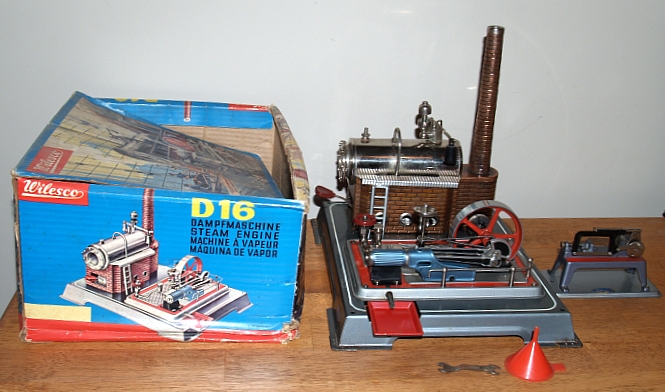The picture below is a large metal toy cement mixer I have.
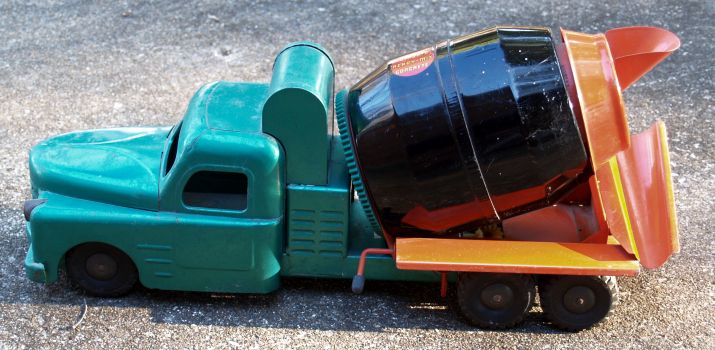
The toy is 21 inches long and 10 inches high. It was made by Structo Toys. The cement drum is connected by plastic gears to one of the rear axles and will rotate as you roll the truck. The cement drum will also tilt rearward as if you are dumping out cement. The picture below shows the drum "unloading" cement.
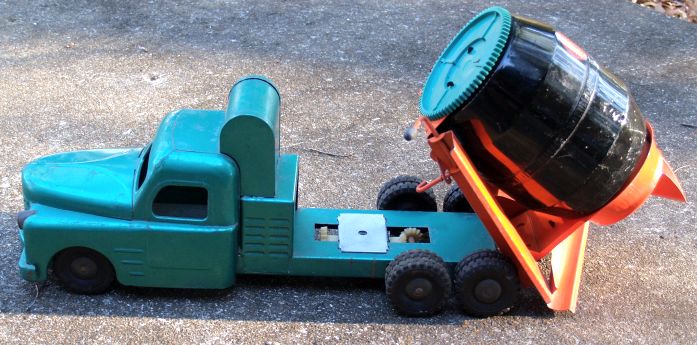
The picture below is a large metal toy Tonka transfer truck I have.
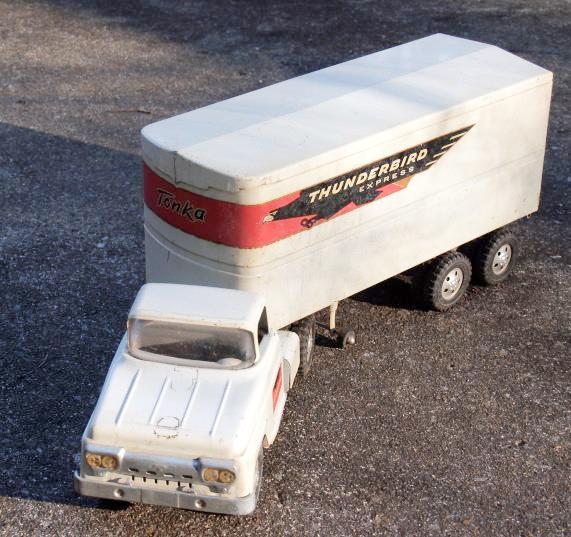
The toy is 24 1/2 inches long and 9 inches high. It was made by Tonka Toys. The cab and trailer will separate and the two doors on the rear of the trailer will open as shown below.
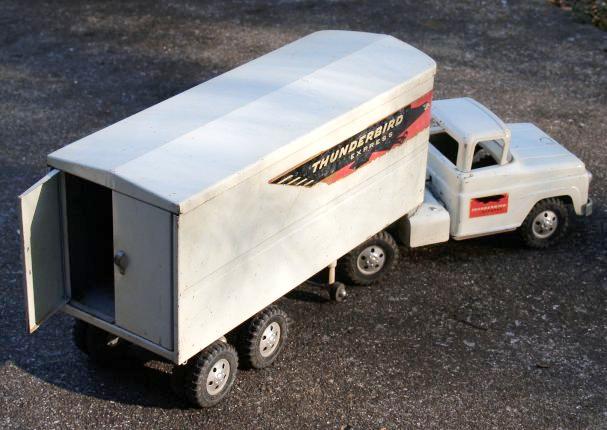
(1958-1959)
The picture below is a large steel metal toy Guided Missile Carrier I have.
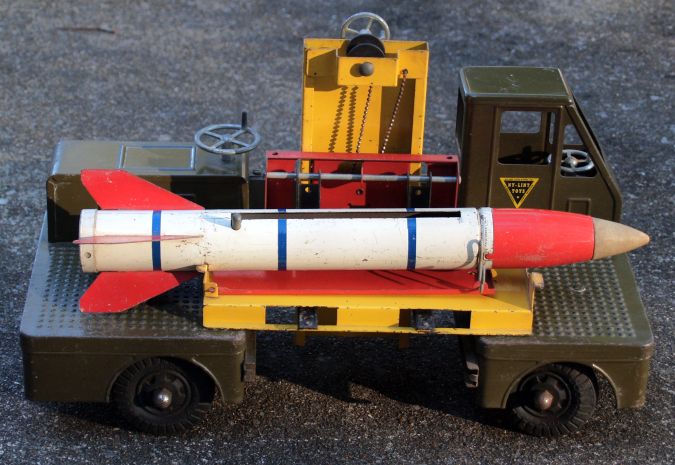
The toy is 15 1/2 inches long and 10 1/2 inches high. It was made by NY-Lint Toys (NY-Lint Tool and Manufacturing Co.) of Rockford, Illnois. Compared to the two toys above, this toy has much more action.
The missile is attached to a pallet and a fork lift attached to the vehicle can lift the missile and pallet off the ground and place it on the vehicle deck for transport. By cranking a handwheel on the vehicle, the fork lift can be extended beyond the vehicle as shown below.The handwheel on the top of the forklift raised and lowers the forks.
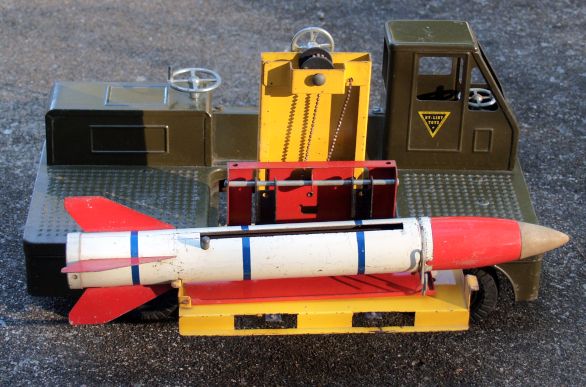
Then the missile can be moved to the vertical position by hand and the missile would be ready to launch as shown below.
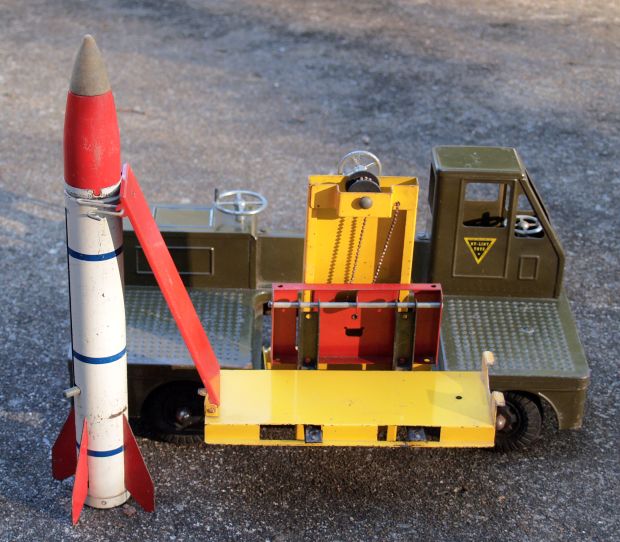
The only part of the missile that actually "launches" is the rubber-tipped nose cone, or "satellite." There is a spring inside the missile that is cocked by a leaver protruding through the side of the missile. All of the pictures show the spring in the cocked position.
The picture below shows the road side of the vehicle. Note the this toy model is authorized by Baker Industrial Trucks, a division of the Otis Elevator Company.
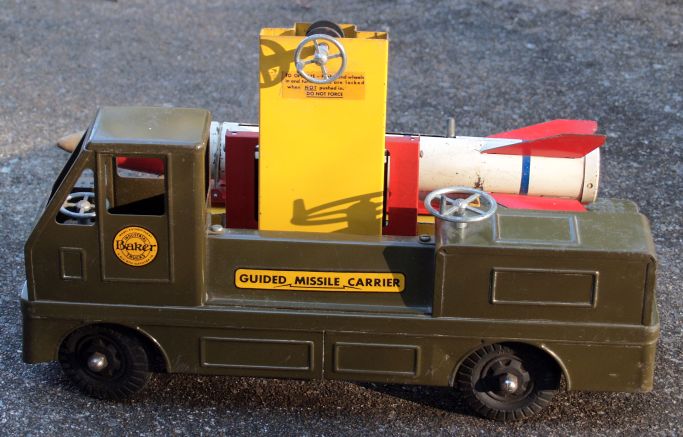
The picture below shows the front of the toy. The front wheels will turn left and right using the steering wheel in the cab.
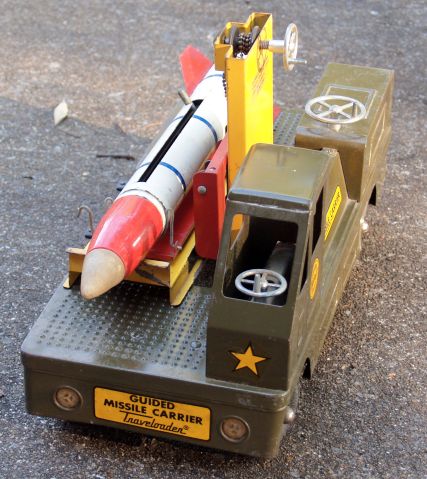
Below are pictures of a toy made by Playskool in the 1960s. It is called the "House Jack Built." It is a simple wooden toy with wood block with various figures on them. The blocks are different shapes and will fit through only the "windows" of the same shape and size. There are doors on both ends. The yellow door has a knob that you rotate to open. The blue door has a hook to latch it. This example is missing some of the pieces, namely the black chimney (that is often missing), a round "malt" block, and a triangular piece with a dog figure on it. It may be missing more blocks. This toy belonged to my sister.
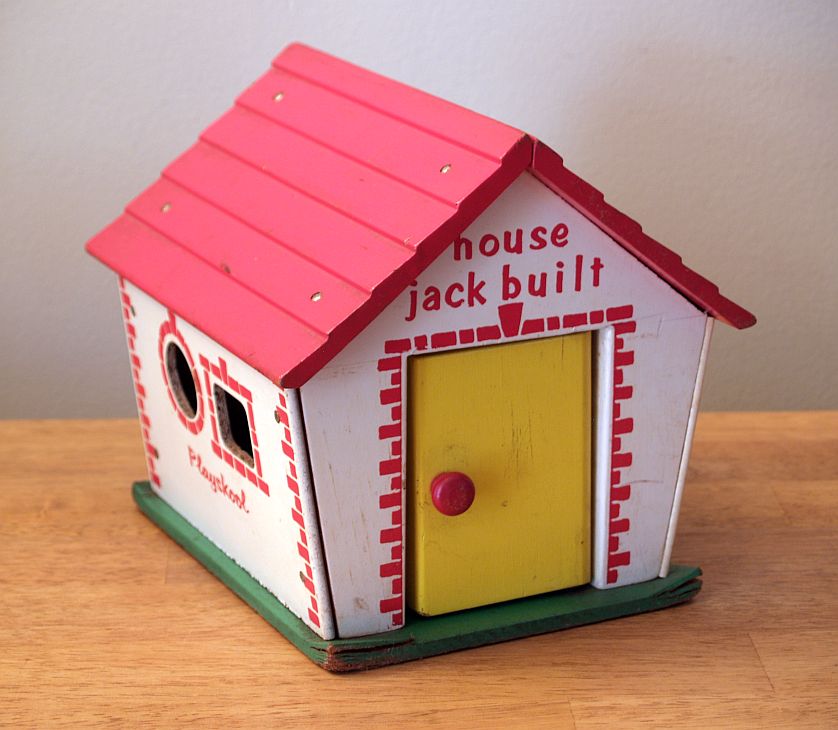
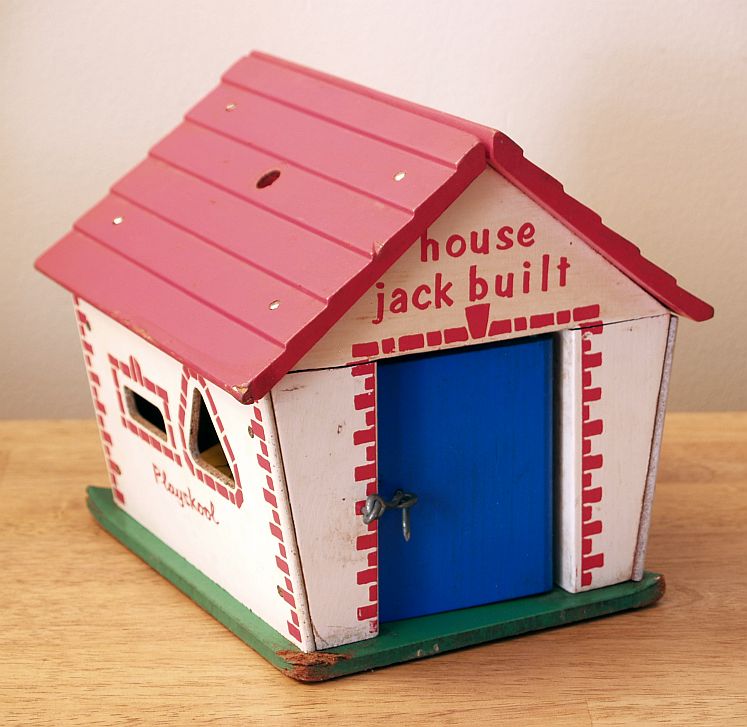
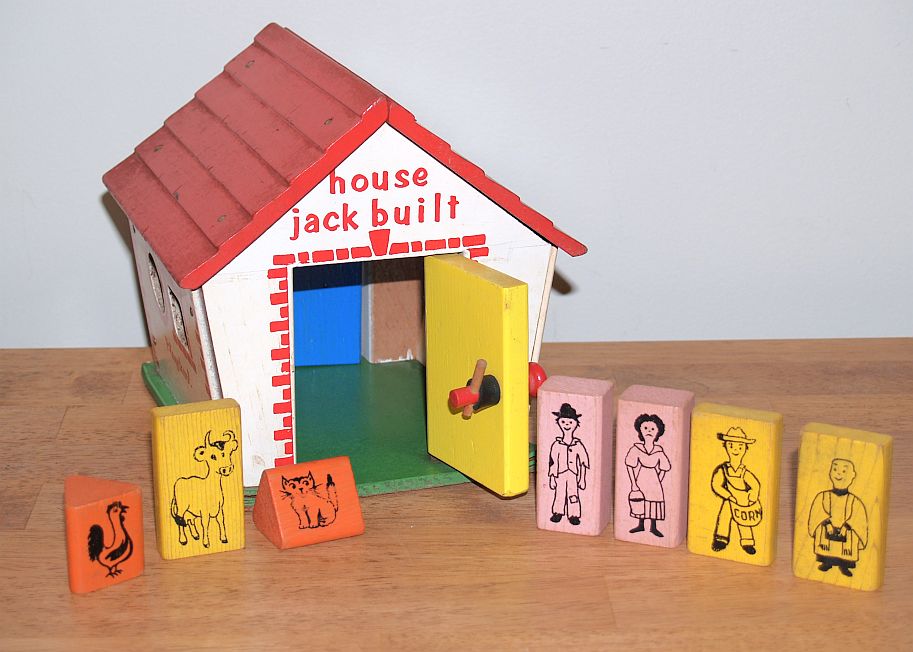
The picture below shows an Astro Base battery-powered toy manufactured in 1960-1961 by Ideal Toy Corporation of Hollis, NY.
I received this toy for Christmas in 1960.
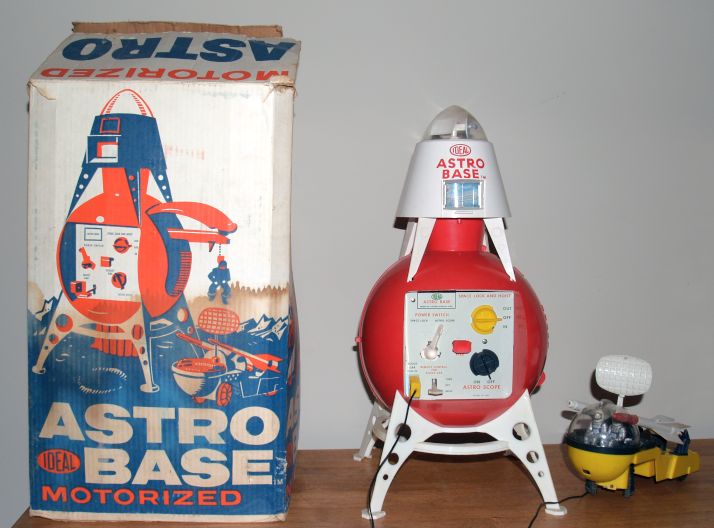
This is a unique toy that uses 4 D-cell batteries. The toy sold for $19.95 in 1960-1961. Sears and Roebuck sold this toy.
Operating this toy will keep a child busy and entertained for a long time. There is a control panel from which all functions are controlled. The lever switch on the top left places the operating mode in either the "Astro Scope" mode or the "Space Lock" mode.
When in the "Astro Scope" mode, using the blue rotary control on the lower right, you can activate the "Astro Scope" that is viewed in the window at the bottom of the conical section on the top of the toy. When activiated, the "scene" as seen through the window changes (a film behind the window rotates) to show space ships flying, planets and other space objects. The "radar" in the clear dome on top of the Astro Base rotates synchronous with the scene changing. You can "kill" the space ships and planets using the red "Rocket Fire" button in the center of the control panel. When pressed, the scene stops and a rat-a-tat-tat (similar to a machine gun sound)is genearated. When the button is released, the scene resumes changing.
When in the "Space Lock" mode, using the yellow rotary control on the upper right you can make the door on the right side to open and a chain hoist with a hook will deploy to pick up things. Reversing the chain hoist, you can bring things inside the Astro Base with the door closing behind the hoist when it is fully retracted. Below is a picture of the hoist lifting the clear dome that covers the astronaut cockpit.
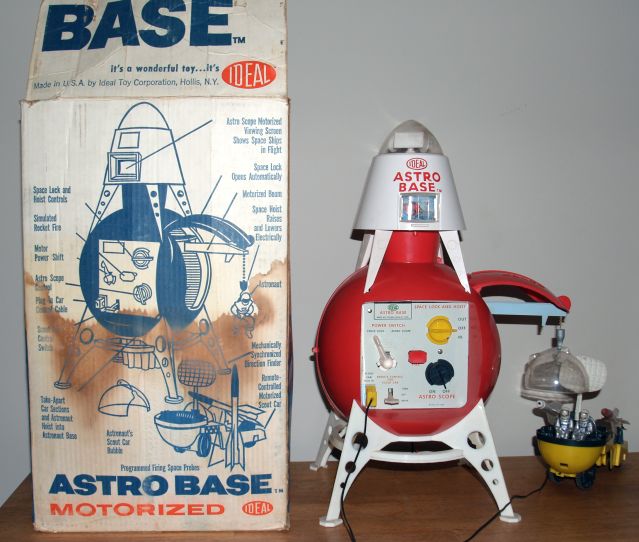
The final feature is the remote-controlled (via long wire) "Scout Car" with astronauts inside and two rockets mounted on either side. This "Scout Car" is seen to the right of the Astro Base. A control on the lower left of the control panel controls two parameters of the car: 1) Drive, and 2) Turn. The car has a single driving motor underneath the astronaut compartment. This is a unique design where reversing the motor causes the drive unit to rotate implementing the turn and non-reversing the motor causes the car to move in the direction in which the drive unit is pointing. The "radar dish" on top indicates the direction the car will move.
The two rockets on the rear of the car can be launched (they are spring-loaded). They are not launched by remote control - they are launched based on distance travel determined by two rotary controls next to each missile. The distance before launched is determined by setting the position of the rorary controls.
Note that I have the original box for this toy. The only pieces that are missing are the two astronauts that came with the toy and the rubber tip for one of the rockets. The astronauts in the picture are not the original pieces - they are from the NASA Gemini model I built. This toy is in working condition after I cleaned corrosion from many of the swittch contact and repaired the wiring to the motor on the car. This toy is powered by only two dc motors - one in the Astro Base and one in the Scout Car. There are no light bulbs to illuminate the toy.
You can see a TV commerical from 1961 advertising the Astro Base by clicking on the picture below. The version of the Astro Base shown in the commercial is slightly different from mine. The placement and style of some of the controls is different from mine and my Scout Car does not have the star decal on the front. My Astro Base may be an earlier version. I never had the helment shown in the commercial.
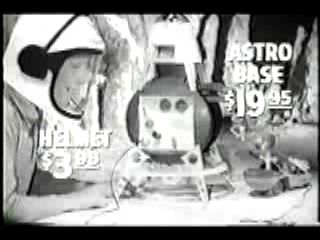
1961 TV Commercial
Below is a picture of me in Christmas 1960 playing with the Ideal Astro Base with my younger sister looking on.
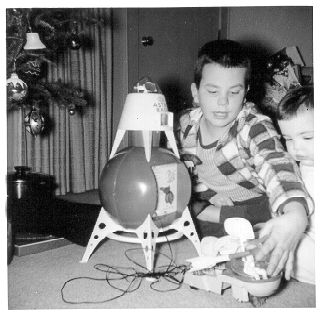
Remco Style No. 712
(1960)
The picture below shows a battery-powered toy manufactured in the early 1960s by Remco Industries Inc. of Newark, NJ.
I received this toy for Christmas in 1960.
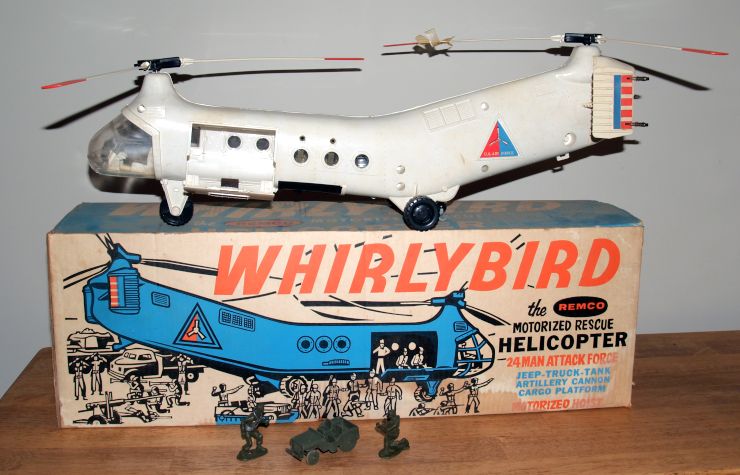
This toy runs on 2 D batteries. When activated, the blades turn and the two mid-body wheels turn. There is a 2-position lever that activates a chain hoist with hook immediately to the rear of the mid-body wheels. One position of the lever raises the hoist - the other position lowers the hoist. When the blades are in motion, there is a rat-a-tat sound inside that simulates the engine of a real helicopter. The on-off switch and hoist control are on the side opposite of that shown.
The toy is modeled after the US Air Force Piasecki H-21 dual-rotot utility helicopter. This helicopter was used in the early years of the Vietnam conflict that was later replaced by the CH-47 Chinook dual-rotor helicopter. The toy is made of white plastic and is nearly 3 feet in length.
Note that I have the original box for this toy. However, two of the six blades are missing and one of the blades I have is broken and taped and glued together long ago. Also most of the 24-man "attack force" men and vehicles are also missing. I have three of them that can be seen in front of the box. The helicpoter body is also discolored in some places.
The helicopter does work. I took it apart and oiled the mechanism and cleaned rust from the hoist chain.
The picture below shows the helicopter with its cargo door closed.
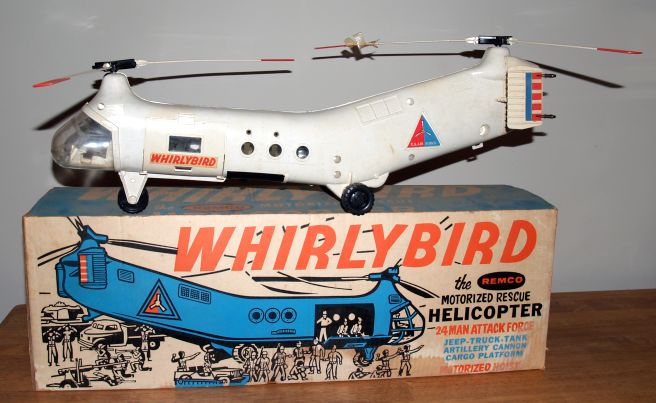
Below is a picture of me holding the helicopter in Christmas 1960 with the Ideal Astro Base beside me.
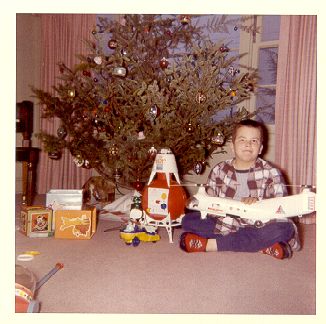
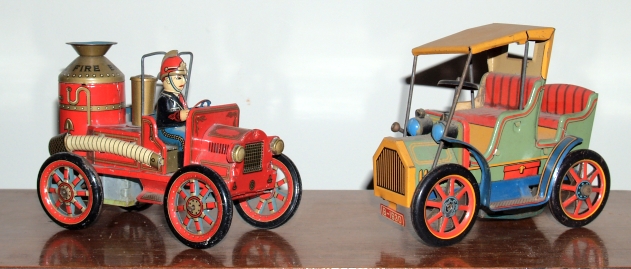
The picture above shows two tinplate toys that I have had a long time. These two toys were made in Japan. The one on the left is a fire engine and when the wheels are turned, you could see sparks inside the transparent windows of the stack on the rear of the vehicle.
The old timey car on the right is missing one of its front wheels. There is a lever on the side opposite shown that when pulled, will wind a spring and when you set the car down after winding the spring, the car will travel until the spring winds down - it winds down quickly.
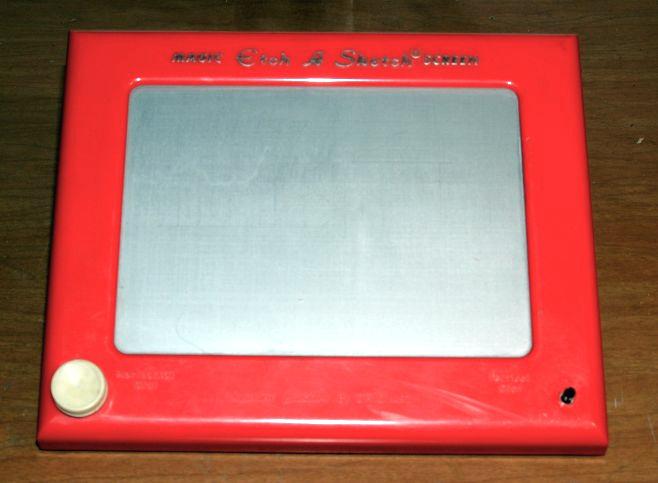
This is an Etch-aSketch screen I had as a child. This toy still works even though one of the two knobs is missing. The left knob moves the sketch line horizontal and the right knob moves the sketch line vertical. Moving both simultaneous make a slanted sketch line. Turning the toy over and shaking in a back and forth motion erases the picture.
Artists have made some astounding pictures with these toys. I was never that good.
Wilesco D16 Toy Steam Engine
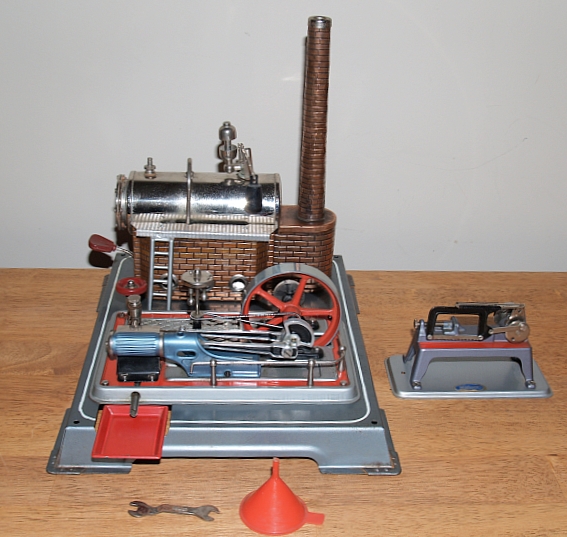
This is a working toy steam engine. This engine was built by Wilesco in Germany and the model number is D16. The boiler is filled with water and heated with pellets similar to "Sterno" that is used for cooking on camping trips. The pellets are placed in a narrow tray that is underneath the boiler. The tray is pulled out by the handle you can see on the left of the boiler.
There is a window on the side of the boiler so you can see the water level. There is a whistle on the top of the boiler. It has a lever arm to which a weight is hung. If the steam pressure is too great, the steam will press up a piston on which the lever arm rests and release pressure through the whistle. Or you can lift the lever arm up and make it whistle as much as you want.
A valve adjusts how much steam gets to the piston/crank/flywheel assembly. A governor with two weights connects to the flywheel axle via a belt. I have one accessory for this engine and it is shown to the right of the engine. This accessory is a horizontal saw that will actually cut soft wood.
I have the funnel for adding water and a wrench, both shown in the picture. I also have the original box for this toy. The steam engine and its box is shown in the picture below.
